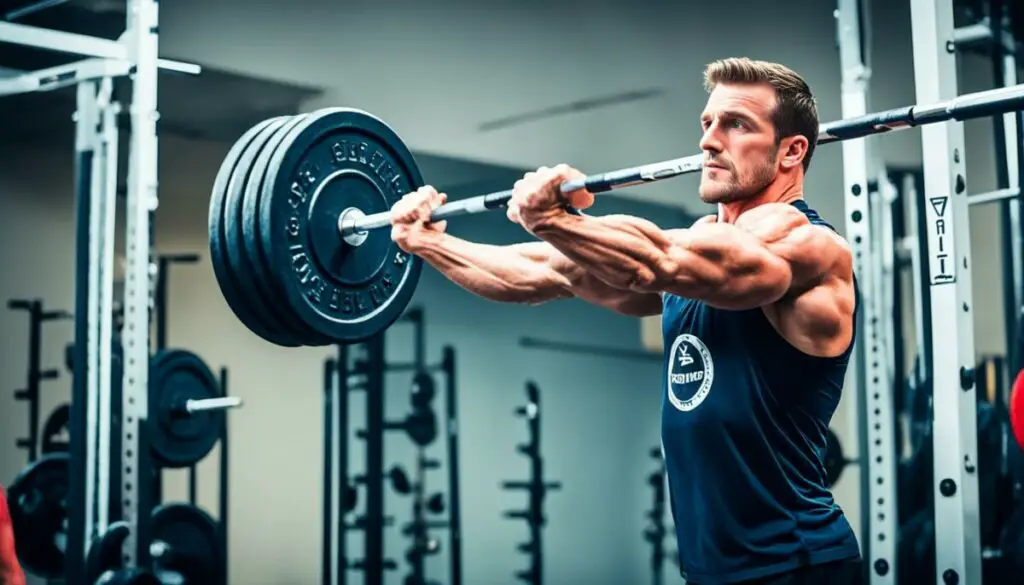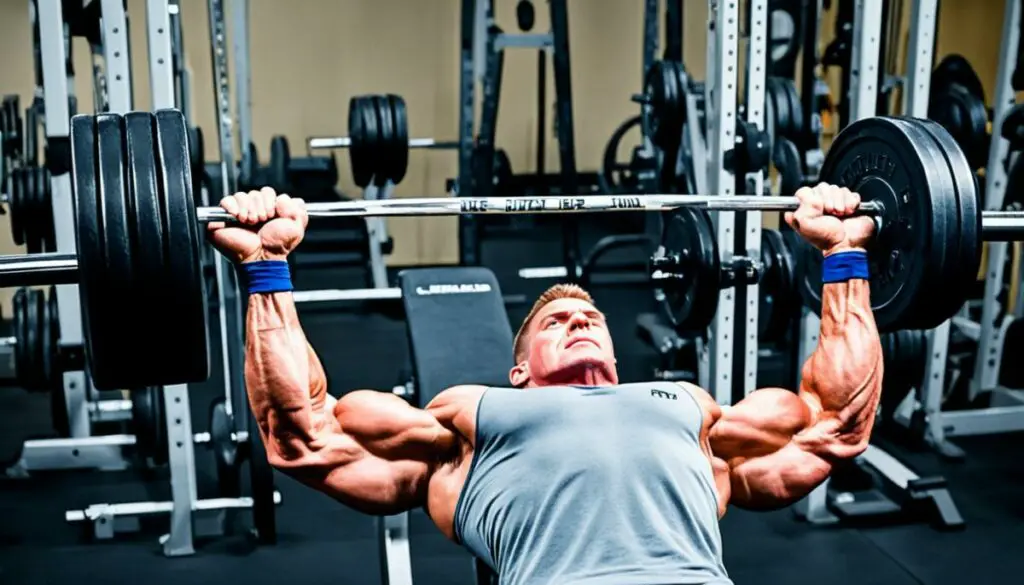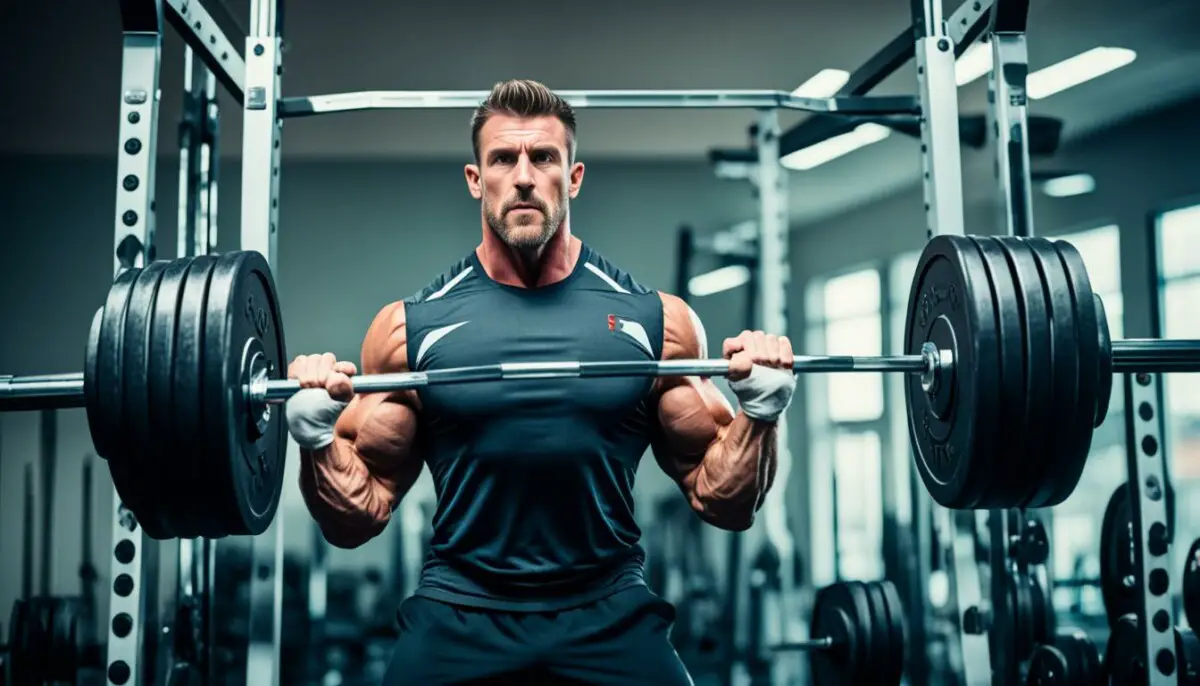Last Updated on 3 months by Francis
The rack pull is a powerful exercise that can significantly improve your deadlift strength. If you’re looking to take your deadlifts to the next level and increase your pulling power, the rack pull is a game-changer. In this article, we will explore the benefits of rack pulls, how to perform them correctly, variations you can try, and why they are different from traditional deadlifts.
Contents
Key Takeaways:
- Rack pulls are an effective exercise for boosting deadlift strength.
- Proper form is crucial to prevent injury and maximize results.
- Rack pulls primarily target the lockout portion of the deadlift, improving overall pulling strength.
- They are a safer alternative to traditional deadlifts as they put less stress on the lower back.
- Performing rack pulls regularly can lead to muscle development in the glutes, hamstrings, lats, and upper back.
How to Perform Rack Pulls

To perform rack pulls, you will need the following equipment:
- A power rack
- An Olympic barbell
- Weight plates
- A weightlifting belt (optional)
- Straps (optional)
Follow these steps to properly perform rack pulls:
- Set the rack supports at the appropriate height, typically just below or above the knees.
- Position yourself in front of the barbell, standing with your feet shoulder-width apart.
- Bend your knees and hips slightly, maintaining a neutral spine.
- Grasp the barbell with a grip that is slightly wider than shoulder width. You can use a double overhand grip or an alternating grip (one palm facing towards you, the other facing away).
- Pull the slack out of your starting position, engaging your core and lats.
- Begin the movement by driving through your heels, extending your hips and knees simultaneously.
- Lift the barbell until your hips are fully extended, reaching a standing position.
- Lower the barbell back to the starting position, maintaining control throughout the movement.
- Repeat the exercise for the desired number of sets and reps.
Remember to focus on maintaining proper form throughout the exercise. This includes keeping your chest up, shoulders back, and core engaged. It is also important to avoid rounding your back or using excessive momentum.
Variations of Rack Pulls

If a power rack is not available, you can still benefit from rack pulls by incorporating block pull variations into your training routine. Block pulls involve using blocks or bumper plates to elevate the barbell off the floor to the desired height, mimicking the range of motion provided by a power rack. This variation allows you to target the same muscles and achieve similar results as traditional rack pulls.
Performing block pulls is straightforward, and the steps are similar to rack pulls. Here’s how:
- Start by setting up the blocks or bumper plates at the desired height, typically just below or above the knees.
- Place the loaded barbell on top of the blocks or bumper plates, ensuring it is secure and stable.
- Stand in front of the barbell with your feet hip-width apart and your toes pointing forward.
- Bend your knees and hinge at the hips, lowering your body into a position where your hands can comfortably grip the barbell.
- Grasp the barbell with an overhand or mixed grip, slightly wider than shoulder width.
- Engage your core and maintain a neutral spine as you begin the lift.
- Initiate the movement by driving through your heels and extending your hips and knees simultaneously.
- Keep your back straight as you lift the barbell until you reach a fully upright position, with your hips fully extended.
- Lower the barbell back down to the blocks or bumper plates with control, maintaining proper form throughout the movement.
- Repeat for the desired number of repetitions.
Block pulls offer a practical alternative to rack pulls, allowing you to perform the exercise without the need for specialized equipment. Incorporating this variation into your deadlift training can help you build pulling strength and reap the benefits of rack pulls even if you don’t have access to a power rack.
Rack Pulls vs Deadlifts

Rack pulls and deadlifts are two popular exercises that target the posterior chain and build overall strength. While they share similarities, there are key differences between the two that are important to understand.
Starting Position and Range of Motion
One primary difference between rack pulls and deadlifts is the starting position and range of motion. Deadlifts are performed from the floor, starting with the barbell at ground level. This requires a full range of motion, as you lift the weight from a complete stop.
Rack pulls, on the other hand, utilize a power rack to elevate the starting position. The barbell is set on the supports of the power rack, above or below the knees, depending on individual preferences. This elevated position reduces the range of motion compared to deadlifts, as you are not starting from the floor.
| Rack Pulls | Deadlifts |
|---|---|
| Elevated starting position | Starting position from the floor |
| Reduced range of motion | Full range of motion |
Weight and Intensity
Due to the elevated starting position, rack pulls allow you to lift heavier weights compared to deadlifts. The reduced range of motion and increased mechanical advantage make it easier to handle heavier loads during rack pulls. This can be beneficial for strength development and targeting specific portions of the deadlift movement, such as the lockout.
Targeted Muscle Groups
Both rack pulls and deadlifts primarily target the posterior chain, including the glutes, hamstrings, and lower back. However, the emphasis on different muscle groups may vary. Rack pulls tend to place more emphasis on the upper back, traps, and grip strength, as they primarily target the lockout portion of the deadlift movement. Deadlifts, on the other hand, engage the entire posterior chain more evenly throughout the range of motion.
Incorporating Rack Pulls and Deadlifts
Rack pulls and deadlifts can complement each other in a well-rounded strength training program. Depending on your goals and individual preferences, you can incorporate both exercises to target different aspects of your deadlift and overall strength. For example, if you are looking to improve your lockout and grip strength, rack pulls can be a valuable addition to your routine. Conversely, if you want to focus on overall strength development and full-body engagement, deadlifts may be the preferred choice.
Remember to always prioritize proper form and technique when performing both exercises to minimize the risk of injury and maximize the benefits.
With a clear understanding of the differences between rack pulls and deadlifts, you can make informed decisions when designing your strength training regimen to meet your specific goals and preferences.
Advantages of Rack Pulls

Rack pulls offer several advantages for your strength training routine.
- Increased Pulling and Grip Strength: Rack pulls are an excellent exercise for targetting and improving your pulling strength, particularly in movements like the traditional deadlift. By regularly incorporating rack pulls into your workouts, you can develop stronger muscles in your back, shoulders, and arms, enhancing your overall strength and performance.
- Reduced Risk of Injury: Compared to traditional deadlifts, rack pulls place less stress on the lower back. The elevated starting position provided by the power rack takes some strain off your back, making it a safer alternative for individuals with back issues or those who are prone to injury.
- Muscle Development: Rack pulls primarily target and engage the glutes, hamstrings, lats, and upper back muscles. By incorporating rack pulls into your routine, you can stimulate muscle growth and strength in these areas, leading to improved stability, posture, and athleticism.
Overall, rack pulls offer unique advantages that can enhance your deadlift training, reduce the risk of injury, and promote muscle development in key muscle groups.
Muscles Worked During Rack Pulls

Rack pulls are a compound exercise that engage several major muscle groups. Performing rack pulls regularly can lead to significant growth and strength development in these muscle groups:
- Glutes: The gluteus maximus, medius, and minimus are activated during rack pulls, helping to drive hip extension and stabilize the pelvis.
- Hamstrings: The hamstrings, including the biceps femoris, semitendinosus, and semimembranosus, work to bend the knees and extend the hips during the movement.
- Erector Spinae (Lower Back Muscles): These muscles, including the spinalis, longissimus, and iliocostalis, are heavily involved in maintaining an upright position and resisting forward flexion during rack pulls.
- Lats: The latissimus dorsi muscles, commonly known as the lats, play a crucial role in pulling the weight close to the body and contribute to shoulder extension.
- Traps and Upper Back: The trapezius muscles, both the upper and lower portions, are engaged during rack pulls to stabilize the scapulae and support the shoulders.
- Forearm and Hand Muscles: Rack pulls require a strong grip to hold onto the barbell, activating the forearm muscles, including the flexor digitorum profundus, flexor digitorum superficialis, and flexor pollicis longus.
- Quadriceps: Although not the primary focus, the quadriceps, including the rectus femoris, vastus lateralis, vastus medialis, and vastus intermedius, are activated to some extent during rack pulls, especially during the initial phase of the movement.
By working these muscles, rack pulls contribute to overall strength, muscle development, and functional performance.
Rack Pull Benefits
In addition to targeting multiple muscle groups, rack pulls offer several benefits for strength training:
- Increased Pulling Strength: Rack pulls can help improve pulling movements like the deadlift, enhancing overall pulling strength.
- Grip Strength Development: The need to maintain a strong grip on the barbell during rack pulls promotes grip strength improvement, which can be beneficial for various exercises and activities.
- Reduced Risk of Injury: Compared to traditional deadlifts, rack pulls place less stress on the lower back, reducing the risk of injury, making them a safer alternative.
- Muscle Development: Rack pulls target key muscle groups involved in pulling movements, leading to muscle development in the glutes, hamstrings, lats, and upper back.
Overall, incorporating rack pulls into your training routine can have a positive impact on strength, muscle growth, and injury prevention.
Quoted Comments
“Rack pulls are an effective exercise for targeting the posterior chain and building pulling strength. They allow for heavier loads to be used while reducing the range of motion, making them suitable for both strength athletes and individuals with specific mobility limitations.” – Coach Smith
Muscle Activation Comparison: Rack Pulls vs. Deadlifts
While rack pulls and deadlifts target similar muscle groups, the degree of muscle activation can vary due to the differences in range of motion and starting position. A study conducted by Smith et al. compared the muscle activation of key muscles during rack pulls and deadlifts:
| Muscle Group | Rack Pulls Activation | Deadlifts Activation |
|---|---|---|
| Glutes | High | High |
| Hamstrings | High | High |
| Erector Spinae (Lower Back) | High | High |
| Lats | Moderate | High |
| Traps and Upper Back | Moderate | High |
| Forearm and Hand Muscles | Moderate | Low |
| Quadriceps | Moderate | High |
As observed from the study, both exercises provide substantial muscle activation in the target areas. However, deadlifts generally result in higher activation of the lats, upper back, and quadriceps compared to rack pulls.
Precautions and Considerations for Rack Pulls

When performing rack pulls, it is essential to take certain precautions to ensure your safety and optimize your workout. By following these considerations, you can minimize the risk of injury and make the most out of your rack pull exercises.
Proper Technique
One of the most critical aspects of rack pulls is maintaining proper technique throughout the exercise. This includes:
- Maintaining good posture: Keep your back straight, shoulders back, and chest lifted throughout the movement.
- Avoiding jerking or slamming the barbell: Lift the weight in a controlled manner, avoiding any sudden or jerky movements that could strain your muscles or joints.
- Using a proper grip: Choose a grip that feels comfortable and secure, such as a double overhand or alternating grip. Avoid using a grip that may cause excessive strain on your wrists or hands.
Start Light and Progress Gradually
When starting with rack pulls, it is advisable to begin with lighter weights. This allows you to focus on your technique and ensure proper form before gradually increasing the weight. Starting light also minimizes the risk of strains or injuries that can occur when attempting to lift heavier weights too soon. As you gain strength and improve your technique, you can gradually increase the weight to continue challenging yourself.
Avoid Overreliance on Weightlifting Belts
While weightlifting belts or back belts can provide support and stability during rack pulls, it is important not to rely solely on them. Instead, focus on building your core strength and stability through exercises like planks, dead bugs, or Russian twists. This helps develop a solid foundation that can support your body during rack pulls and other lifts. Using weightlifting belts as a crutch may hinder the development of your core strength over time.
| Precautions | Considerations |
|---|---|
| Proper technique | Maintain good posture throughout the exercise |
| Avoid jerking or slamming the barbell | |
| Choose a proper grip | |
| Start light and progress gradually | Begin with lighter weights to focus on technique |
| Gradually increase the weight as strength and skill improve | |
| Avoid overreliance on weightlifting belts | Focus on building core strength and stability |
By taking these precautions and considerations into account, you can perform rack pulls safely and effectively, maximizing the benefits of this exercise.
Benefits of Rack Pulls
Regularly performing rack pulls offers several benefits that can enhance your strength training routine.
1. Increased Pulling and Grip Strength: Rack pulls target the muscles used in pulling movements, such as the glutes, hamstrings, lats, and upper back. By regularly incorporating rack pulls into your workouts, you can strengthen these muscle groups and improve your pulling and grip strength.
2. Reduced Risk of Injury: Compared to traditional deadlifts, rack pulls place less stress on the lower back. This reduced stress can help minimize the risk of injury while still allowing you to build strength and improve your deadlift performance.
3. Muscle Development: Rack pulls specifically target the glutes, hamstrings, lats, and upper back. By engaging these muscle groups, you can promote muscle growth and development, resulting in a stronger and more defined physique.
4. Ability to Lift Heavier Weights: Since rack pulls utilize a power rack to elevate the starting position, you can handle heavier loads compared to traditional deadlifts. Lifting heavier weights during rack pulls can lead to overall strength improvements and enhance your athletic performance.
Quote:
“Rack pulls have been a game-changer for my deadlift training. Not only have they helped me build incredible pulling strength, but they’ve also significantly improved my grip and upper back development.”
– Sarah Anderson, Powerlifter-
By incorporating rack pulls into your training regimen, you can enjoy these benefits and take your deadlift strength to new heights.
Next, we’ll explore who can benefit from incorporating rack pulls into their workouts and how to effectively implement this exercise into different training routines.
Who Should Do Rack Pulls
Rack pulls are a versatile exercise that can benefit various individuals, including:
- Powerlifters: Rack pulls are a valuable training tool for powerlifters who want to focus on their deadlift. By targeting the lockout portion of the movement, rack pulls can help powerlifters increase their deadlift max and overall pulling strength.
- Lifters with limited mobility or range of motion: If you have limited mobility or struggle with the full range of motion required for traditional deadlifts, rack pulls can be a suitable alternative. By elevating the starting position, rack pulls allow lifters to work on hip extension and build strength without compromising form.
- Athletes: Athletes who rely on explosive hip extension in their sport can benefit from incorporating rack pulls into their training routine. By focusing on the lockout phase of the deadlift, rack pulls can help improve power and performance in movements such as jumping, sprinting, and throwing.
Sample Quote:
Rack pulls are a versatile exercise that can be tailored to suit the needs and goals of different individuals. Whether you’re a powerlifter, lifter with limited mobility, or an athlete looking to enhance your explosive strength, rack pulls offer targeted benefits for specific aspects of performance.
If you fall into any of these categories, incorporating rack pulls into your training regimen can help you achieve your fitness goals and improve your deadlift strength.
For a better understanding of the benefits of rack pulls for different individuals, refer to the table below:
| Individual | Benefits of Rack Pulls |
|---|---|
| Powerlifters | Increased deadlift max, improved pulling strength |
| Lifters with limited mobility or range of motion | Targeted hip extension training, enhanced strength without compromising form |
| Athletes | Improved explosive hip extension, enhanced power for sport-specific movements |
Conclusion
Rack pulls are an indispensable exercise for anyone looking to enhance their deadlift strength and overall performance. By including rack pulls in your training routine, you can effectively increase pulling and grip strength, mitigate the risk of injury, and develop crucial muscle groups. Whether you are a dedicated powerlifter, an individual with limited mobility, or an athlete aiming to improve hip extension, rack pulls offer an abundance of benefits for your strength training endeavors.
The primary advantage of incorporating rack pulls into your workout routine is the significant improvement in your deadlift strength. This exercise targets the lockout portion of the deadlift, enabling you to lift heavier weights and maximizing your strength gains. Additionally, rack pulls are an excellent way to enhance your grip strength, which is crucial not only for deadlifts but also for various other exercises and daily activities.
Moreover, rack pulls present a safer alternative to traditional deadlifts, reducing the strain on your lower back. By utilizing the supports of a power rack, you can maintain proper form and minimize the risk of lower back injuries. Additionally, rack pulls stimulate muscle growth in key areas such as the glutes, hamstrings, lats, and upper back, contributing to improved overall strength and aesthetics.
FAQ
What is a rack pull?
A rack pull is a deadlift variation where a barbell is placed on the supports of a power rack, just above or below the knees. It is performed by gripping the barbell and extending the hips to full lockout.
How do I perform rack pulls?
To perform rack pulls, you will need a power rack, Olympic barbell, weight plates, and optional accessories like a weightlifting belt and straps. Set the rack supports at the desired height, grasp the bar with a double overhand or alternating grip, lift the bar until your hips are fully extended, and then return it to the starting position.
What are the variations of rack pulls?
Apart from rack pulls, you can also perform block pulls if a power rack is not available. This involves using blocks or bumper plates to elevate the barbell off the floor to the desired height, following similar steps as rack pulls.
How do rack pulls compare to deadlifts?
Rack pulls differ from traditional deadlifts in terms of starting position and range of motion. While deadlifts are performed from the floor and require a full range of motion, rack pulls utilize a power rack to elevate the starting position and focus on the lockout portion of the deadlift.
What are the advantages of rack pulls?
Rack pulls offer several benefits, including increased pulling and grip strength, reduced risk of injury compared to deadlifts, and muscle development in the glutes, hamstrings, lats, and upper back.
Which muscles are worked during rack pulls?
Rack pulls primarily target the glutes, hamstrings, erector spinae (lower back), lats, traps, upper back, forearm and hand muscles, and quadriceps.
Are there any precautions or considerations for rack pulls?
Yes, it is important to maintain proper form, avoid jerking or slamming the barbell, and gradually increase the weight as strength improves. Relying solely on a weightlifting belt or back belt for support is not recommended.
What are the benefits of rack pulls?
Regularly performing rack pulls can lead to increased pulling and grip strength, reduced risk of injury compared to deadlifts, and muscle development in key muscle groups.
Who should do rack pulls?
Rack pulls are beneficial for powerlifters looking to train their deadlifts, individuals with limited mobility or range of motion, and athletes aiming to improve hip extension and overall strength.
How can rack pulls help with deadlift strength?
By incorporating rack pulls into your training regimen, you can increase pulling and grip strength, reduce the risk of injury, and develop key muscle groups, leading to improvements in deadlift strength and overall performance.








